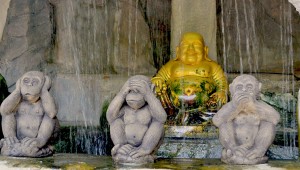Hear, see more and talk less!
 During a recent trip to Thailand, I came across statues of the three wise monkeys. They were accompanied by a gold colored Buddha, set in a cave where a continuous stream of water fell from above, whose trickling sounds added a feeling of peace. I do not know the history behind this setting or how old it is. It was one of those coincidences we experience in our lives, as the three wise monkeys had been on my mind prior to travelling 12000 km and accidentally finding this special spot.
During a recent trip to Thailand, I came across statues of the three wise monkeys. They were accompanied by a gold colored Buddha, set in a cave where a continuous stream of water fell from above, whose trickling sounds added a feeling of peace. I do not know the history behind this setting or how old it is. It was one of those coincidences we experience in our lives, as the three wise monkeys had been on my mind prior to travelling 12000 km and accidentally finding this special spot.
I’m not the only one apparently, as there are many worldwide collectors of the different styles and materials used in producing statues, that depict the three wise monkeys.
It is not clear as to their origins, but it is thought to have occurred 400 years ago in Japan where the three monkeys are known as Mizaru, who covers his eyes and sees no evil; Kikazaru, who covers his ears and who hears no evil; and Iwazaru, who covers his mouth and speaks no evil.
In Buddhist tradition, the proverb is about not dwelling on evil thoughts. Depending on the country, there are various meanings attached to the three wise monkeys that relate to being of good mind, speech and action.
It may also signify a code of silence in gangs, or organized crime.
Monkeys have been held sacred and/or in high esteem for centuries: the Hanuman Languor in India, the Rhesus Macaque in China and the Japanese Macaque (Snow Monkey) in Japan. Monkey folklore existed centuries before Taoism, Buddhism or Confucianism.
Mahatma Gandhi was the leader of the Indian independence movement and among other attributes, author of the Seven Social Sins. The one notable exception to his lifestyle of non-possession was a small statue of the three monkeys. There seems to be a parallel between Gandhi’s seven social sins and the proverb of the three wise monkeys. The photo below was taken at the tomb site of Mr. Gandhi in New Delhi, India. Proverbs are used in numerous cultures, the most well known source being the Book of Proverbs in the Bible.







